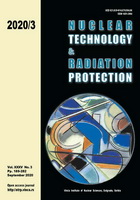
ENVIRONMENTAL RADON, ITS EXHALATION RATES AND ACTIVITY CONCENTRATION OF 226Ra, 232Th, AND 40K IN NORTHERN INDIA

Vol.
XXXV, No. 3, Pp. 189-282
September 2020
UDC 621.039+614.876:504.06
ISSN 1451-3994
Pages: 268-282
Authors: Rupinderjeet Kaur, Deep Shikha, Supreet Pal Singh, and Vimal MehtaAbstract
Human beings are constantly exposed to radioactivity in the environment. As they are major sources of harmful radiation, radionuclides found in the atmosphere might result in a substantial potential risk to living beings. On the Earth's surface, the radioactive elements uranium and radium are naturally present, contributing to radon and thoron gases in the indoor as well as outdoor climate, soil and water. Radon is one of the most important toxins that, after cigarette smoking, is the second most common cause of generating lung cancer. Due to these health-related concerns, a lot of work has been undertaken by numerous research organizations to determine their levels at different locations throughout the world. This paper is an attempt to comprehensively report with different techniques all those studies being carried out in this part of India so that a current assessment of the indoor radon levels should be available for further work in this field. Six northern Indian states, viz. Punjab, Haryana, Himachal Pradesh,
Rajasthan , Uttar Pradesh and Uttarakhand are considered for this examination.
This study also provides data on exhalation rates and activity concentration of natural radionuclides (226Ra, 232Th, and 40K) present in these states.
Key words: indoor radon, thoron, exhalation rate, annual dose, activity concentration
FULL PAPER IN PDF FORMAT (402 KB)